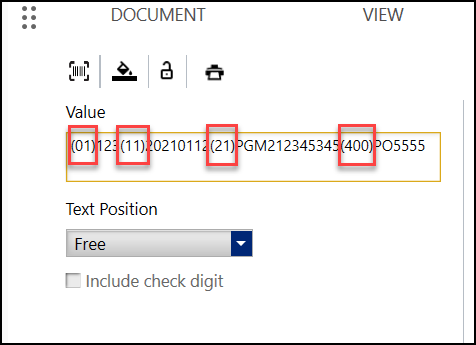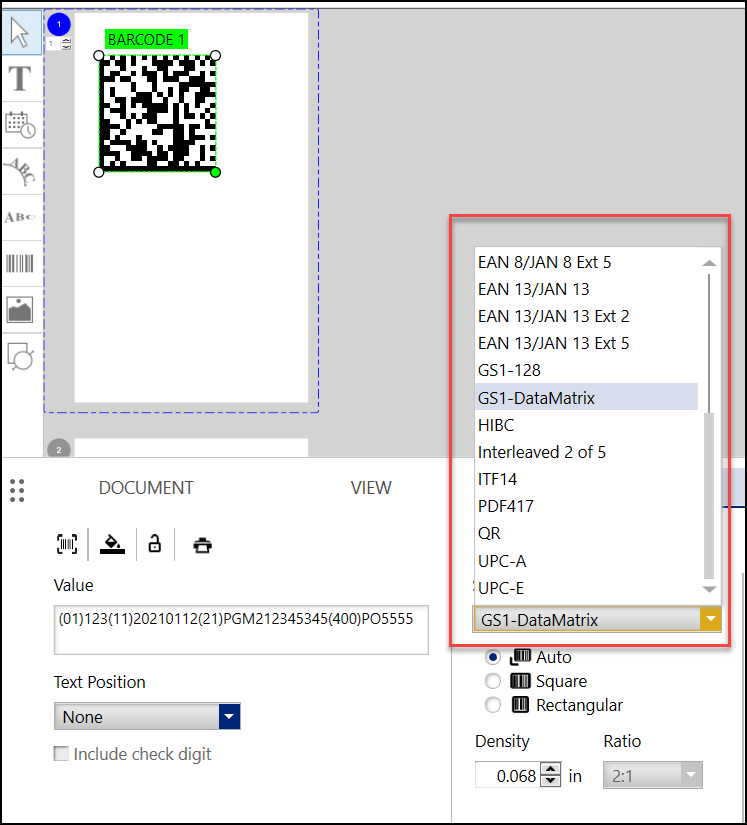GS1 Barcode Compliance in Brady Workstation
GS1 is a symbology standard created by a not-for-profit organization that develops and maintains global standards for barcodes. Brady Workstation provides tools to create GS1 barcodes, however the end user must determine the appropriate formatting required by their project.
Symbology standards requirements may vary by industry: medical, pharmaceutical, aerospace, electronics, retail, etc. Some examples are listed below.
GS1 = Global Standards
EAN = International (European) Article Number
UCC = Universal Commercial Code
UPC = Universal Product Code
What Makes a Barcode GS1 Compliant?
GS1 compliance is achieved when a specific type of barcode symbology is combined with data that is properly formatted using Application Identifiers (AI).
While the GS1 standard has no formal specification (character set, minimum and maximum lengths, construction, restrictions, etc.), a GS1 compliant barcode symbology usually does have format specifications. More information regarding GS1 Architecture can be found on their website. Application Identifiers (AIs)
Application identifiers allow users to format barcode data so that multiple types of data are included within a single barcode, such as a serial number and date of manufacture.
AIs are also known as Data Identifiers (DIs). A common AI for GS1 is FNC1 (Function Code One) an invisible code used to identify and separate fields of data. Other invisible codes include Code A B or C, Modulo10 to calculate check digits, and single or multiple FNC1 codes.
Application Identifier Examples
The FNC1 codes are displayed in the human readable as 2 or 4 digit codes that identify the data that follows the FNC1. For example:
- (01) indicates the data that immediately follows is the GTIN (Global Trade Identifier Number)
- (11) is the FNC1 for Date of Manufacture
- (21) prefaces Serial Number
- (400) is the identifier for Customer’s Purchase Order Number.

Application Identifiers separating multiple pieces of data.
GS1 Symbology Standards in Brady Workstation
The following barcode symbologies are available in Brady Workstation and can be used to create barcodes that meet the GS1 symbology standard:
| GS1 DataMatrix |
| GSI-128 |
| HIBC |
| QR Code |
| UPC-A |
| UPC-E |
| EAN 8/JAN 8 |
| EAN 8/JAN 8 Ext 2 |
| EAN 8/JAN 8 Ext 5 |
| EAN 13 /JAN 13 |
| EAN 13 /JAN 13 Ext 2 |
| EAN 13 /JAN 13 Ext 5 |
Creating GS1 Compliant Barcodes in Brady WorkstationGS1 compliant barcodes can be created using the Custom Designer app. Values can be manually typed, imported from Excel or Combine Fields can be used to build the value from separate components. Reference these articles to get started:
Note: Because of the complexity and uniqueness of each barcode (which barcode symbology is being used, what data is being included in that barcode), it is up to the user to make sure the data complies with the GS1 standard they are using.
 GS1 barcodes can be added when creating labels or templates in the Custom Designer app.
GS1 barcodes can be added when creating labels or templates in the Custom Designer app.




